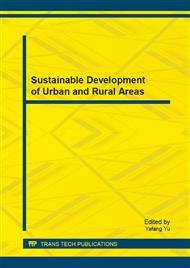[1]
Molenaar, A., Design of Flexible Pavement, Lecture Note CT 4860 Structural Pavement Design. 2007, The Netherlands: Delft University of Technology.
Google Scholar
[2]
Shojaei Baghini, M., et al., The Potentials of Portland Cement and Bitumen Emulsion Mixture on Soil Stabilization in Road Base Construction. Jurnal Teknologi, 2013. 65(2): pp.67-72.
DOI: 10.11113/jt.v65.2193
Google Scholar
[3]
Wayne S. Adaska, C., State-of-the-art report on soil-cement, in ACI Materials Journal. 1997, ACI Committee 230. 1R-90.
Google Scholar
[4]
Wu, P., A. Molenaar, and I.L. Houben, CEMENT-BOUND ROAD BASE MATERIALS, Report 7-11-218-1. 2011, Delft University of Technology, PowerCem Technologies, Netherlands.
Google Scholar
[5]
Xuan, D.X., et al., Mechanical properties of cement-treated aggregate material – A review. Materials & Design, 2012. 33(0): pp.496-502.
DOI: 10.1016/j.matdes.2011.04.055
Google Scholar
[6]
Garber, S., R.O. Rasmussen, and D. Harrington, Guide to Cement-based Integrated Pavement Solutions. 2011, Institute for Transportation, Iowa State University. Portland Cement Association.
Google Scholar
[7]
Shojaei Baghini, M., et al., Bitumen-cement stabilized layer in pavement construction using indirect tensile strength (ITS) method. Research Journal of Applied Sciences, Engineering and Technology 2013. 5(24): pp.8652-8656.
DOI: 10.19026/rjaset.5.4251
Google Scholar
[8]
Freeme, C.R., et al., Mechanistic Design of Asphalt Pavements and Verification Using the Heavy Vehicle Simulator. 1982: National Institute for Transport and Road Research.
Google Scholar
[9]
Xuan, D., Literature review of research project: structural properties of cement treated materials. 2009, Report 7-09-217-1, Section Road and Railway Engineering, Delft.
Google Scholar
[10]
Bell, F., Engineering treatment of soils. 2002, London: E & FN Spon: Taylor & Francis.
Google Scholar
[11]
NITRR, Cementitious Stabilizers in Road Construction. 1986: National Institute for Transport and Road Research (South Africa), South Africa. Dept. of Transport, Committee for State Road Authorities (South Africa). Highway Materials Committee, Committee of State Road Authorities (South Africa).
DOI: 10.1787/888933580859
Google Scholar
[12]
PCA, Soil-Cement Laboratory Handbook. 1992, Publication EB052. 07S, Skokie, Illinois: Portland Cement Association.
Google Scholar
[13]
ACI , C., State-of-the-art report on soil-cement. ACI Materials Journal, 1990. 87(4): pp.395-417.
Google Scholar
[14]
ASTM, American Society for Testing and Materials (ASTM). Annual Book of ASTM Standards. 2004, West Conshohocken, Pa.
DOI: 10.1002/ep.670180104
Google Scholar
[15]
Davidson, D.T., Soil Stabilization with Portland Cement. 1961: Highway Research Board Bulletin.
Google Scholar
[16]
Little, D.N. and S. Nair, Recommended Practice for Stabilization of Subgrade Soils and Base Materials. 2009: National Cooperative Highway Research Program, Transportation Research Board of the National Academies.
DOI: 10.17226/22999
Google Scholar
[17]
UFC 3-250-11, Soil stabilization for pavements. 2004, Unified Facilities Criteria (UFC), TM 5-822-14/AFJMAN 32-1019, departments of the army the navy and the air force.
Google Scholar
[18]
DFID, Literature review: stabilised sub-bases for heavily trafficked roads. 2003, Department For International Development, R6027, R8010.
Google Scholar
[19]
Gaspard, K., Evaluation of Cement Treated Base Courses. 2000, Louisiana Transportation Research Center, Louisiana Department of Transportation and Development, Number 00-1TA.
Google Scholar
[20]
SAPEM, South African Pavement Engineering Manual. 2009: South African National Roads Agency Ltd.
Google Scholar
[21]
BS 1924, Stabilized materials for civil engineering purposes, General requirements. 1990, British Standards Institution London, UK.
Google Scholar
[22]
MRTS08. 1, Plant-Mixed Stabilised Pavements using Cement or Cementitious Blends. 2010, Department of Transport and Main Roads Technical Standard, Australia.
Google Scholar
[23]
Molenaar, A.A., et al. Prediction of the mechanical characteristics of cement treated demolition waste for road bases and subbases. in Proceedings of the 10th conference on asphalt pavements for Southern Africa, KwaZulu-Natal, South Africa. (2011).
Google Scholar
[24]
JTJ034, Technical specifications for construction of highway roadbases. 2000, Beijing: Ministry of Communications of the People's Republic of China.
Google Scholar
[25]
CCANZ, Cement Stabilisation. 2008, Cement & Concrete Association of New Zealand, IB89.
Google Scholar
[26]
AASHTO, AASHTO Guide for Design of Pavement Structures. 1993, Washington,D. C: American Association of State Highway and Transportation Officials.
Google Scholar
[27]
ACI, State-of-the-Art Report on Soil Cement. 1997, ACI 230. 1R-90, American Concrete Institute.
Google Scholar
[28]
ARMY, Soil stabilization for pavements, in TM 5-822-14/AFJMAN 32-1019. 1994, Department of the Army, the Navy and the Air Force: WASHINGTON, DC.
Google Scholar
[29]
Jones, D. and D. Jones, Guidelines for the Stabilization of Subgrade Soils in California. 2010, UCD-ITS-RR-10-38, Institute of Transportation Studies ◦ University of California, Davis: California.
Google Scholar
[30]
Lade, P.V., C. Liggio, and J.A. Yamamuro, Effects of non-plastic fines on minimum and maximum void ratios of sand. ASTM geotechnical testing journal, 1998. 21(4): pp.336-347.
DOI: 10.1520/gtj11373j
Google Scholar


